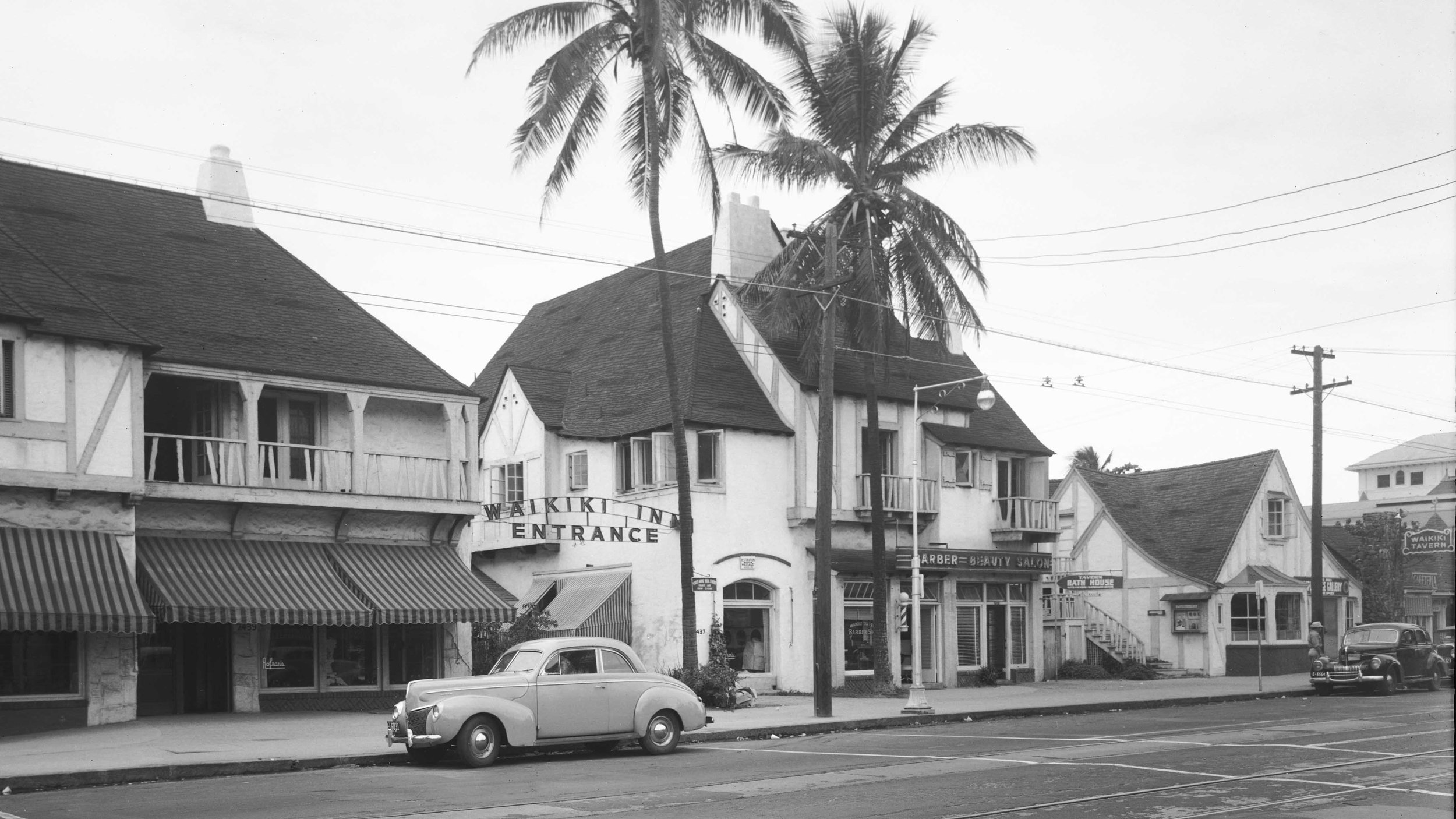
WAIKĪKĪ TAVERN
Starting probably in the 1880s, a succession of restaurants and bars were situated in a location on what is now Kūhiō Beach in Waikīkī. After going through a variety of owners and names, what had become the enlarged Waikiki Tavern and the connected Waikiki Inn opened in November 1928. Anachronistically designed to resemble a 1700s tavern in Nottingham, England, the entire complex had hotel or rental rooms for 104 people, seven retail spaces facing the sidewalk, and could accommodate 160 diners in the Tavern. A cluster of five guest cottages and a gas station stood across Kalākaua Avenue on the mauka side as well.
We know that for at least a time just before World War II, the Waikiki Tavern was a meeting place for gay men. This information comes from a famous novel published in 1951 titled From Here to Eternity. Its author, James Jones, drew heavily upon his actual personal experiences in the US Army while he was stationed at Schofield Barracks in central Oʻahu before, during, and after the Japanese attack on December 7, 1941, the time when the book’s story takes place.
Eternity contains a lengthy sequence of over 30 pages in which the main character Robert E. Lee Prewitt (“Prew”) and his friend Angelo Maggio interact with the latter’s gay male friend in Waikīkī in 1941. Remarkable as it seems today, heterosexual Army men of the time are described as forming relationships with civilian gay men in which limited sexual activity was allowed in exchange for financial support and a chance to visit the comfortable civilian world of expensive liquor and attractive apartments. This was so accepted that Maggio complains that he is fighting too much competition from his fellow soldiers for the limited number of gay men.
The Waikiki Tavern is the scene of Prewitt’s meeting with Maggio’s friend Hal. Prew agrees to be set up with Tommy, a friend of Hal’s, as the former’s date. The book describes the Tavern’s
…subdued atmosphere of richness with the pyramids of glasses doubling themselves in the mirror and the smooth-spoken barmen that always made you feel low class…
Maggio tells Prew that nine men they know are regulars here, seeking to meet homosexual men, and two fellow soldiers then enter with five civilian men to sit at a large table together.
One of these is described by Hal as “that big effeminate blond” who goes by the name Flora, who is now dating Nathan Bloom, another soldier from Prew’s company who is with this group at the table. Flora is obviously gay (or perhaps transgender) and, notably, living openly in Honolulu in 1941:
…Prew watched the blond run his fingers carefully over his [permanent-waved] hair and then, moving his…big white fluttering hands, elaborately, get up and walk…swaying…to the men’s room.
These interactions are happening not in a clandestine business secretly catering to a gay clientele, but instead in a popular and well-patronized restaurant in a busy part of Waikiki. Hal, who falsely claims he “doesn’t care who knows” about his sexuality, is shown to be a regular and respected customer of the Waikiki Tavern when, as the four men leave, at the door:
[t]hey walked out past the same hulking bouncer who saluted Hal with one finger, bowing a little…
Prew and the three others walk to Hal’s nicely-furnished Waikīkī apartment on the second floor of a small walk-up wooden building, but the evening soon ends badly with angry, bitter conversations and Maggio drunkenly stomping out into the dark streets. Prew manages to convince Hal to give him increasing amounts of cash to retrieve Maggio and return him safely to Schofield Barracks, ending up with $40, which today would be comparable to more than $800.
Again, although written as fiction, it’s likely that From Here to Eternity does carry a great deal of truth. As such, it gives us a view of the culture of a time we otherwise would be unlikely to ever know.
And what eventually happened to the Waikiki Tavern? It continued to pass through the hands of different entrepreneurs before the land it stood on, owned by the Steiner family, was condemned by the City & County of Honolulu in the late 1950s. After all the leases of the various business occupants there had expired, the entire complex was demolished in April 1960. Since then it has been a public beach park which today is known as the site of the Duke Kahanamoku statue. Also, very close by in this same open space is the important LGTBQ+ site of the Healer Stones of Kapaemahu which commemorate a group of māhū (transgender) healers of centuries ago.
Story by DeSoto Brown.
Image Credits:
Banner - Ray Jerome Baker, Bishop Museum Archives / SB 31227
Image 1 - Book cover “From Here to Eternity” by James Jones 1951, fair use
Images 2, 3, 4 - The DeSoto Brown Collection





